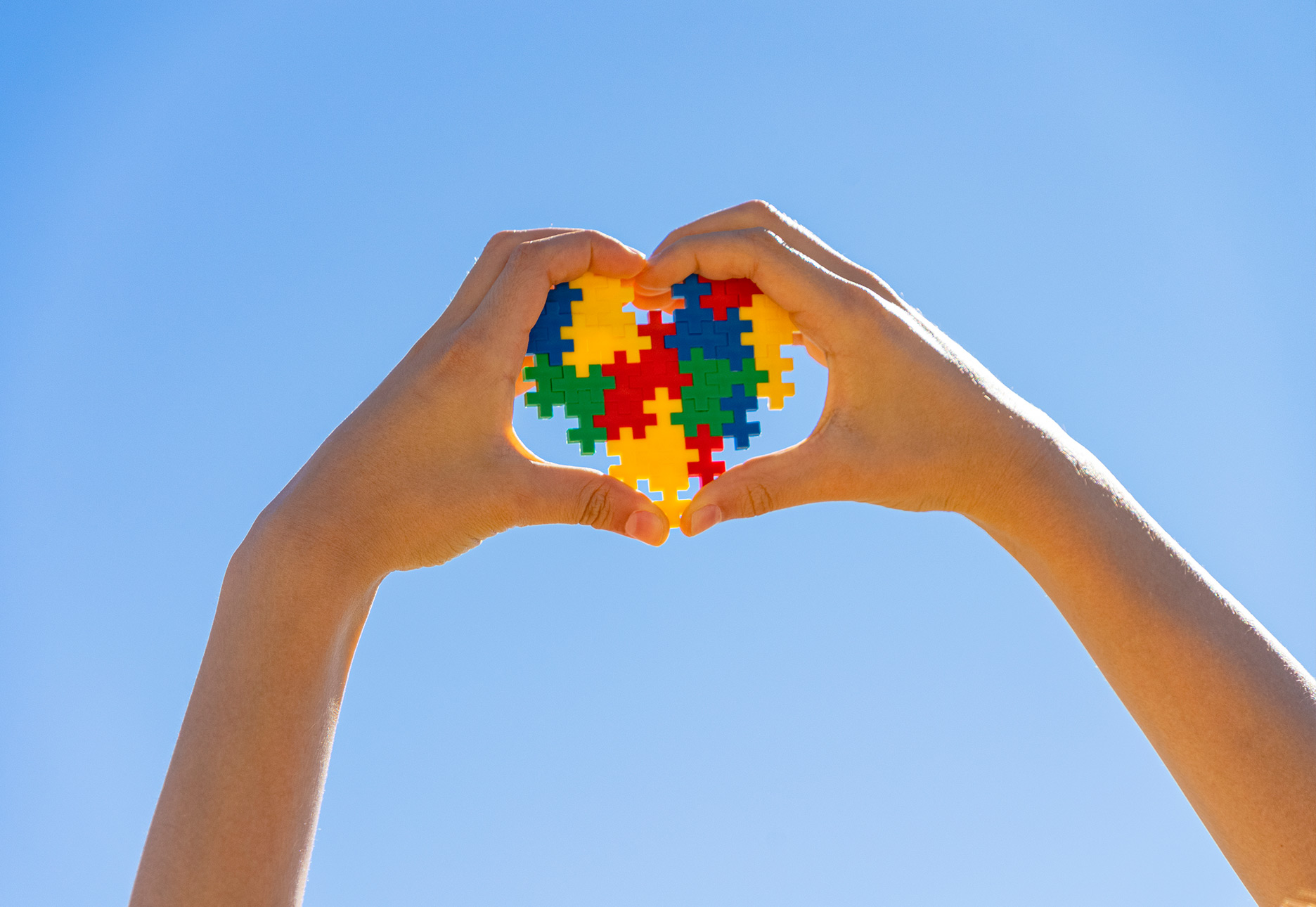Child hands holding colorful puzzle piece heart on blue sky background.
When I was pregnant with my first child, I often imagined who my child would be. I was working as a freelance writer and editor, so I read through countless books, articles, and blogs in preparation for my imminent maternity. During this time, I would also occasionally take on work as a substitute teacher. One of my assignments was to co-teach a kindergarten course. The lead teacher celebrated my pregnancy, but then offered a startling piece of information which I never forgot: she told me that she and the other educators in the school had noted a marked increase in the number of students who had been identified with Autism Spectrum Disorder (ASD). She explained to me that the numbers had been growing substantially over the last few decades, and that while no one had yet presented clear and proven evidence about the reasons for the growing prevalence, there were a number of unproven hypotheses in circulation regarding certain environmental factors.
My family has since grown to include four wonderful and unique children, but this incident resonated with me throughout my children’s earlier years, and especially when I realized that one of my children was exhibiting some behaviors that are indicative of an individual with Autism Spectrum Disorder. While my child is intellectually gifted and high-achieving in a number of areas, there are some social situations that remain elusive and challenging for us all. Since my child is a high-functioning individual, many people misunderstand and misinterpret how my child acts in social settings and think they are being brusque or rude. As a mother, it has been challenging for me to think about the future and that perhaps their life will not be quite what I envisioned; but conversely, I understand that their unique way of thinking and processing information is extraordinary. My child sees the world from an innovative perspective and my family is not alone in coming to terms with this situation.
Indeed, the frequency of ASD diagnoses has markedly increased since the beginning of the millennium. According to research from The Autism Society (2019) in the year 2000, the prevalence rate for autism spectrum disorder was one in 125. Currently, 1 in 54 children are identified with ASD (Maenner, et al., 2020). ASD occurs in all racial, ethnic, and socioeconomic groups but it is at least four times more common among boys than girls (Maenner, et al., 2020).
It is important to clarify that ASD includes a wide and vast range of behaviors and no two individuals present in exactly the same way. ASD is defined as “a developmental disability that can cause significant social, communication and behavioral challenges” (CDC, 2020, par 1). To clarify, the diagnosis includes, “several conditions that used to be diagnosed separately: autistic disorder, pervasive developmental disorder not otherwise specified (PDD-NOS), and Asperger syndrome. These conditions are now all called autism spectrum disorder” (CDC, 2020, par. 2).
There are a number of events and resources available to assist parents, guardians, educators, and others to understand and assist individuals with ASD. The month of April marks many important events regarding autism awareness. April 2 is World Autism Awareness Day and the month of April in the United States is noted now as both National Autism Awareness Month and Autism Acceptance Month.
Experts at the Autism Society of America (2021) explain that while April has been designated as “Autism Awareness Month” in the United States they encourage revising the name to “Autism Acceptance Month.” The reason for this change is to create acceptance and consider systemic changes that make better opportunities in employment, resources and quality of care for those individuals with ASD. (Autism Society of America, 2021).
On a global scale, April is also noted as World Autism Awareness Month. According to staff writers at Autism Speaks (2021), Autism Awareness month was created “to increase understanding and acceptance of people with autism, fostering worldwide support” by sharing stories and passing on knowledge (par 1). We can pass on knowledge and become more informed about ASD in many ways. The Autism Society of America has a variety of resources designed to inform and encourage communities to celebrate differences, and become more inclusive of individuals with autism.
The Autism Society of America is marking the month through a new “Celebrate Differences” campaign. Designed to build a better awareness of the signs, symptoms, and realities of autism, #CelebrateDifferences focuses on providing information and resources for communities to be more aware of autism, promote acceptance, and be more inclusive in everyday life.
Autism Speaks offers a number of resources at autismspeaks.org/wam.
There are a number of other helpful resources posted through Autism Speaks including the following:
Connect with the Autism Response Team who will provide real-time support, guidance and reliable information and services through an information hotline. You can also access a number of online seminars at: https://www.autismspeaks.org/events.
References
Autism Society. (2020) Autism Acceptance Month. Autism Society. https://www.autism-society.org/get-involved/national-autism-awareness-month/
Autism Society. (2021 March 4). Media Urged to Recognize Shift From Autism Awareness Month to Autism Acceptance Month This April. Autism Society. https://www.autism-society.org/releases/media-urged-to-recognize-shift-from-autism-awareness-month-to-autism-acceptance-month-this-april/
Centers for Disease Control and Prevention. (2020). What is Autism Spectrum Disorder? National Center on Birth Defects and Developmental Disabilities, Centers for Disease Control and Prevention. https://www.cdc.gov/ncbddd/autism/facts.html
Maenner, M. J., Shaw, K. A., & Baio, J. (2020). Prevalence of autism spectrum disorder among children aged 8 years—autism and developmental disabilities monitoring network, 11 sites, United States, 2016. MMWR Surveillance Summaries, 69(4). 1.



